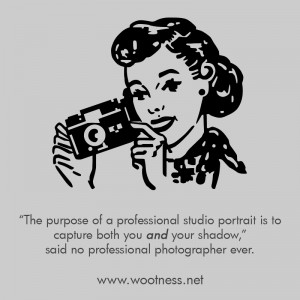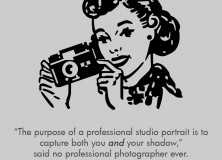 Oh good morning Wootness fans! Happy Groundhog Day! Phil did NOT see his shadow, so I guess that means we’ll have an early spring. Yeah, right. When I start relying on a rodent to forecast the weather, there’s issues at play.
Oh good morning Wootness fans! Happy Groundhog Day! Phil did NOT see his shadow, so I guess that means we’ll have an early spring. Yeah, right. When I start relying on a rodent to forecast the weather, there’s issues at play.
So, today we’re gonna talk about shadows. Specifically, shadows from your clients that are cast onto your lovely photographic backgrounds. You SO have learned not to use bedsheets, right? No? Please back up and read THIS first.
OK, the rest of you, listen up. Take a good look at your client portraits. If the client casts a shadow on the background, they are TOO CLOSE to it. I’m not going to dig up an example of this on the internet, because it’s just not nice to use someone’s work as an example of what NOT to do – unless one of you dear readers would like to help out with an example (I’ll keep your name confidential), but anyway – I think we all know if we’re casting shadows or not. Please note that I am referring to shadows on the background behind the client, not shadows on the floor leading away from the client.
I’m telling you – the shadows will give you away as an amateur. There are various reasons as to WHY the shadows appear, and I’m sure that I’ll be hearing some of them in the comments shortly – but here’s the deal. Either you didn’t know that you should put your clients at least 6-8 feet in front of the background OR you know it and don’t care because you just don’t have that much room in front of your backgrounds to work with. So – to the former – I’m telling you to pull your clients out 6-8 feet (experiment with that, but that’s a general measurement to get you started) and to the latter – suck it up – if you don’t have the room to shoot with technical excellence, you need to find somewhere else to shoot. Do not force the issue and continue to churn out work with shadowy backgrounds because you’ve got your studio set up in the corner of your house or you made a bad decision to rent/lease/buy a space too small for your needs.
You can’t deliver quality work without the proper tools. You not only need to have the right camera, lenses, lights, triggers, modifiers, etc, but you must also have the right SPACE.
If you just can’t change the space you’re working with, you need to change the type of things you shoot. Ditch the full body family groups and stick to heads and shoulders only. By not insisting on the amount of room needed between you and the client for full(er) body images, you can pull your clients away from the background and closer to you and stick to head/shoulders/upper body shots.
Working within your limits, skill-wise, equipment-wise and space-wise is the mark of a professional or at least an aspiring professional. Please stop trying to do work that you are not fully prepared to do. The RIGHT way.

I generally agree with your advice about shadows on the background being sloppy. But don't forget, every rule was meant to be broken. There are some great portrait and fashion photographers intentionally throwing shadows on their seamless.
That may be all well and good, but this site is not written for great portrait and fashion photographers. It is advice for new photographers who have not yet learned the rules to begin with.